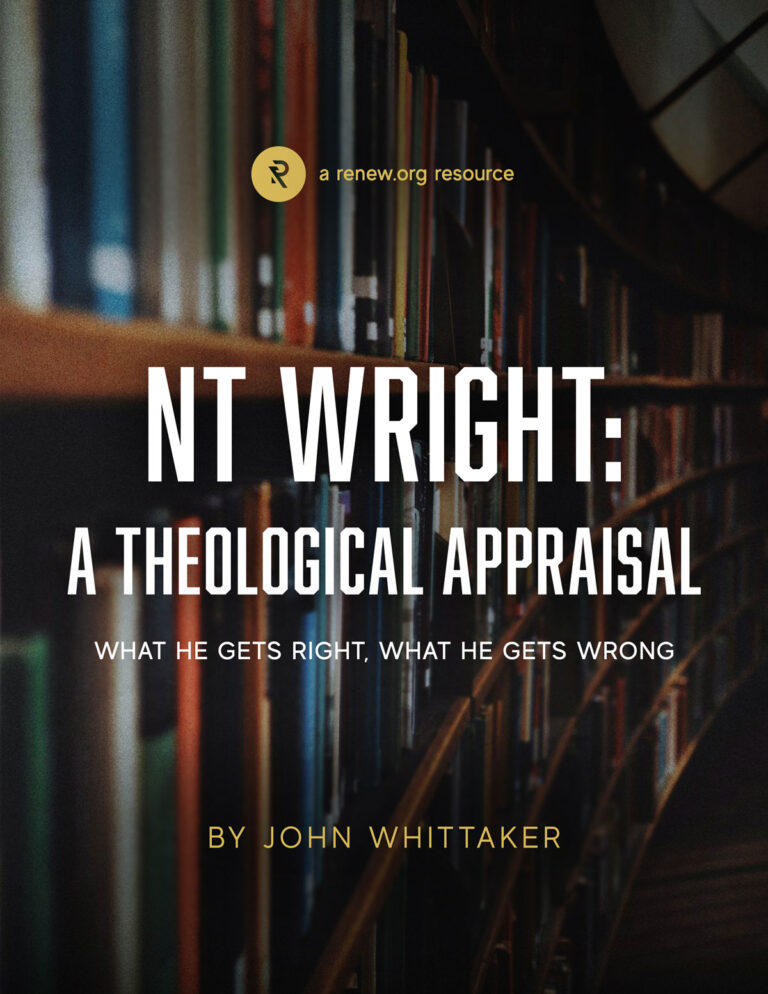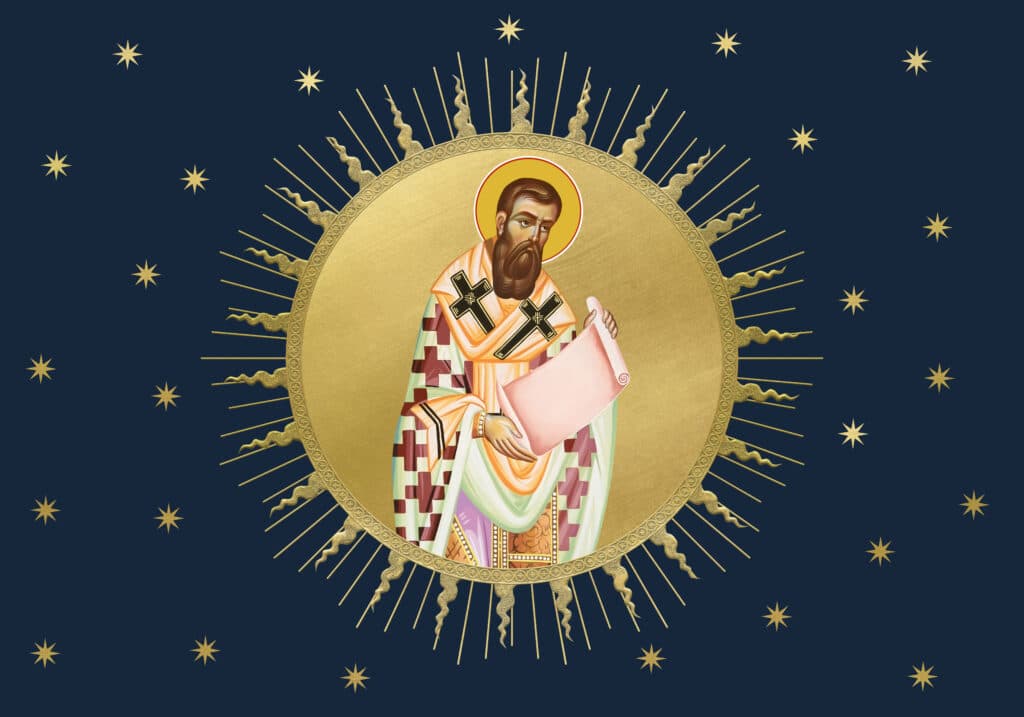Gregory Palamas is a name that frequently appears in the study and reading of the history and doctrine of the Eastern Orthodox Church.* Multiple authors quote his writings, and others cite theologians who have used Palamas’s work to defend their theology. This oft-quoted theologian desired a life of quiet retirement for prayer, but his career as a monk and priest involved him beyond his desires into politics and intrigue. He would receive honors, but his teachings would also be condemned. His life was a series of ups and downs, with an imprisonment and capture by invaders.[1]
Throughout his life, Gregory was writing. Through these diverse writings, readers can understand his theology, which made Gregory Palamas “as central a figure in the East as Thomas Aquinas is in the West,”[2] even acquiring the name “Palamism” to his theology. Gregory was influential during his time and Palamism continues to influence the Eastern Church. In order to understand the whole Eastern Church, it is essential to study the life, theology, and influence of Gregory Palamas.
The Life of Gregory Palamas
Gregory Palamas was born into a noble Anatolian family, most likely from Constantinople[3] whose situation helped establish his career early in life but also set him up for the political ups and downs that would follow him throughout his life. Gregory’s father was a member of the Senate in the royal court.[4] As a result, Gregory was well-educated in Aristotelian principles, including rhetoric.[5] His education would serve him well throughout his life.
At a young age, Gregory saw the monks from Mount Athos[6] and became personally attracted to monasticism. First, he studied in Constantinople under Theoleptos, the Metropolitan of Philadelphia, until 1316, when he went to live at Mount Athos.[7] At Mount Athos, Palamas had his first experience with the hesychast tradition of mystical prayer.[8] He studied ascetic literature and practiced a strict monastic life.[9]
This early time at Mount Athos set the pattern for Gregory’s life; he would follow the hesychast tradition and ascetic practices throughout his life. “In 1325, St. Gregory was chosen by the monks of Athos to go to the Holy Land to represent them in a pilgrimage. When he arrived in Thessalonica, he found out that he could not continue his journey because of the Turkish blockade.”[10] In Thessalonica, Palamas lived a solitary prayer life except for prayer celebrations on Saturday and Sunday.[11]
“At a young age, Gregory saw the monks from Mount Athos and became personally attracted to monasticism.”
After Thessalonica, Palamas lived the classical hesychastic life at Berrhoea in a hermitage;[12] until due to the plundering of northern barbarians, the monks left Berrhoea and returned to Mount Athos. In about 1335, Gregory was chosen to be the abbot of the Monastery of Esphigmenou. He began to publish writings that drew him “into the arena of theological controversy, ecclesiastical strife, and political turmoil.”[13]
Gregory’s writings caught the attention of Barlaam,[14] a Greek monk from Calabria. Barlaam, influenced from Western philosophy, stated the doctrine of God’s unknowability in an extreme form, which Gregory criticized.[15] Barlaam in turn attacked the contemplative practices of the hesychasts. Gregory’s “fellow monks called upon him to go to Thessalonica and defend their views against Barlaam the Calabrian.”[16] This task would not be simple.
Palamas traveled to Thessalonica in 1338 to meet with Barlaam and resolve their dispute. “As hopes of resolution faded, Palamas composed the first of the Triads, a three-part series consisting of three treatises in each part.”[17] Monks from Mount Athos supported Gregory’s writing in a statement known as “Hagioritic Tome” during a synod in 1340-1341.[18]
“Barlaam, influenced from Western philosophy, stated the doctrine of God’s unknowability in an extreme form, which Gregory criticized.”
The dispute then led to four councils in Constantinople (in 1341, 1344, 1347, and 1351). “Three of these councils excommunicated Barlaam and affirmed Gregory’s theology; the one in 1344 supported Barlaam and condemned Gregory, but it was overturned by the last two.”[19] Palamas’s life was in a series of ups and downs being played out in councils observed by bishops, patriarchs, and Emperor Andronicus III, who attended them.[20] During this time, political concerns[21] also caused a six-year civil war, and Palamas’s political opponents imprisoned him for four years, after which he was set free.[22]
While traveling, Palamas was taken prisoner by Muslim forces and held captive in Asia Minor.[23] Even though he was held captive, he still had some freedom and could visit the Christians in the area.[24] After Palamas was ransomed, he was honored by the new emperor[25] and appointed as archbishop of Thessalonica[26] in 1347.[27] But Palamas could not take possession of his position until 1350 due, once again, to political problems.[28] Palamas’s experience of captivity, being ransomed, and then honored by an emperor demonstrates the ups and downs that followed Gregory Palamas throughout his life.
In 1352 Gregory’s health began to fail.[29] When he could, Gregory spent his energy in the care of his flock. “He delivered his homilies, which are evidence of his great ability to pastor. But because of the political circumstances, the religious conflicts, and the great unrest of the times, he could not be always with his beloved flock.”[30] Gregory Palamas cared for the people he served but was disrupted from this care by the unrest in the land where he lived.
“Gregory Palamas cared for the people he served but was disrupted from this care by the unrest in the land where he lived.”
The traditional date of Gregory Palamas’s death is November 14, 1359, although some scholars place the year 1357.[31] Gregory’s followers and friends worked to have Gregory canonized, and Gregory would be proclaimed a saint by the Synod of Constantinople in 1368.[32] “His feast was also celebrated on the Second Sunday of Great Lent as a reminder that his doctrine was not simply that of an individual, but that of the whole Eastern Church”[33], thus establishing Gregory’s importance to the Eastern Church and Eastern theology.
What Is Hesychasm?
Because of the controversy with Barlaam, Gregory is most well-known for the theology surrounding hesychasm. During his life, Gregory Palamas supported the hermits who practiced hesychasm and he practiced hesychasm himself. The roots of hesychasm go back to early Egyptian monks who lived at the time of Athanasius,[34] who engaged “in continuous prayer and contemplation.”[35]
Geffert and Stavrou write that the term “hesychast,” which originally referred simply to a desert ascetic such as Evagrius Ponticus (345-399), came to indicate a person who sought inner peace, quietude, and mystical union with God through prayer.”[36] The Greek word hesychia means “quietude,” “stillness,” or “tranquility.”[37] The term meaning stillness was used by the Desert Fathers and then by John Chrysostom, St. Gregory of Nyssa, and St. Basil the Great.[38] The first hesychasts sought quiet, stillness, and union with God in prayer.
The term came to mean more, particularly at Mount Athos. “Hesychast writings circulated throughout Eastern Christendom under the names of various authors, including the pseudonymous ‘Macarius,’ whose work found an especially receptive audience on Mount Athos.”[39]
“Because of the controversy with Barlaam, Gregory is most well-known for the theology surrounding hesychasm.”
Before Gregory, there were hesychast writings, but they didn’t appear in written documents until the late-thirteenth and early-fourteenth centuries.[40] “The chief texts embodying the hesychast teaching on prayer are collected in the Philocalia of St Nicodemus of the Holy Mountain.”[41] Nicephorus the Hesychast and Gregory of Sinai also described hesychasm. Even though it was not written about in documents for many years, the method was widely known.[42]
Beyond quiet prayer, hesychasm came to be defined by a specific prayer technique easily identified by the participants’ posture, whose goal was to unite the heart with the intellect. For those living in monastic communities, the “exercises were taken as a complete way of life.”[43] Those who practiced hesychasm would adopt a posture and attitude of prayer.
“[I]t was felt that the heart was the leader of the body and that the intelligence must descend into the heart. By making one’s breathing coincide with the prayer until it became an unconscious repetition, one advanced spiritually to the vision of God.”[44]
The breathing of hesychasm was closely linked with the “Jesus Prayer.” The Jesus Prayer typically took the form, “Lord Jesus Christ, Son of God, have mercy on me.”[45] This prayer seems simple, but “[c]onducted properly, the Jesus Prayer could be prayed with every breath and with every beat of the heart: physiology intertwined with psychology and spirituality.”[46]
“Beyond quiet prayer, hesychasm came to be defined by a specific prayer technique easily identified by the participants’ posture, whose goal was to unite the heart with the intellect.”
The bodily posture taken by the hesychasts is head bowed and eyes fixed on the place of the heart. The physical elements of the prayer were not essential but were considered an accessory to “secure what they termed ‘the union of the mind with the heart,’ so that their prayer became ‘prayer of the heart.’”[47] The goal was to use the psychosomatic method “for placing a man literally “in attention,” ready to receive the grace of God—provided, of course, he deserve it by “observing the commandments.””[48]
Hesychasm is said to be for contemplation of the divine light. “Saint Symeon the New Theologian (d. 1042) contended that “contemplation of the divine light” is attainable by the ascetics after a “purification” of the soul has taken place.”[49] Therefore, contemplation of the divine light was not available to everyone, but only after purification through prayer. “The Hesychasts held this Light to be identical with the Light that surrounded the Lord at His Transfiguration on Mt. Tabor, and to be none other than the uncreated energies of the Godhead.”[50] The divine energies would become a central part of the controversy with Barlaam.
Barlaam VS Palamas on Hesychasm
Barlaam objected and saw this type of prayer as an “obstacle to a true ‘intellectual’ encounter.”[51] Barlaam distrusted the mystical bent of the hesychasts and the fact that the hesychasts put reason and philosophy as a secondary or irrelevant concern. Barlaam was not a pure scholastic[52] but was among a group intent on developing pro-Western thought among Eastern Christians.[53]
As stated previously, Gregory wrote Apodeictic Treatises on the Procession of the Holy Spirit against Barlaam,[54] embarrassing him. Barlaam began to use sarcasm to characterize the monks of Athos.[55] Barlaam “rejected the hesychasts as omphaloscopoi, or “naval gazers,” considering them, as described by John Meyendorff in Byzantine Theology: Historical Trends and Doctrinal Themes, “intellectually unqualified fanatics.” The breathing tutorials, in particular, struck Barlaam as nonsense, as did the suggestion that the body (not only the mind) could be transfigured by the divine light.”[56] Palamas responded, relying on Gregory of Nyssa’s distinction between God’s essence and God’s energies, using Nyssa’s work to show himself Orthodox and hesychasm compatible with Orthodox Christianity.[57]
“Palamas responded, relying on Gregory of Nyssa’s distinction between God’s essence and God’s energies, using Nyssa’s work to show himself Orthodox and hesychasm compatible with Orthodox Christianity.”
A council in 1341 in Constantinople went on to rebuke Barlaam. Barlaam thus left Byzantium in disgrace to live in Italy. Gregory Palamas’s victory came again when later councils endorsed Palamas’s theology.[58] Palamas theology would receive further endorsement posthumously in 1368 when the Eastern Church canonized him.[59]
Gregory Palamas and God’s Essence–Energies
The controversy with Barlaam over hesychasm centered around deeper theologies of God’s knowability and divine “energies.” There is no modern Western theological equivalent to what Palamas meant by “energies.” Some equate it to deifying grace, but it also encompasses foreknowledge, mercy, justice, God’s healing truth, wisdom, love, and divine will. According to Aristotelian roots, Gregory’s use of the word suggests that energies are what God does in the world.[60] To the Eastern Church, the essence of God is unknowable, but the energies are the power of God at work in the world.”[61]
Closely tied with hesychasm is the question, “Is God knowable?” as well as the theology known as “apophatic theology.” “Apophaticism literally means a ‘turning away from speech’ and implies that experience of the divine in quiet stillness (hesychasm) is far more revelatory than deductive logic.”[62]
For the East and the hesychasts, experience revealed more than reason:
“In the [East]… apophatic theology is regarded as fundamental. Here it is seen as an affirmation that God cannot be an object of knowledge at all; this doctrine is given classic expression in the teaching of St. Gregory Palamas that God’s essence is unknowable, while He makes Himself known to us through His energies.”[63]
“The controversy with Barlaam over hesychasm centered around deeper theologies of God’s knowability and divine ‘energies.'”
The idea is that reason cannot make God known, nor can God be known in his essence. God can only be known through the experience of his energies. John Meyendorff, in Byzantine Theology, explains:
“Knowledge of God is an experience given to all Christians through Baptism and through their continuous participation in the life of the Body of Christ in the Eucharist. It requires the involvement of the whole man in prayer and service through love for God and neighbor, and then it becomes recognizable not only as an ‘intellectual’ experience of the mind alone but as a ‘spiritual sense,’ which conveys a perception neither purely ‘intellectual’ nor purely material.”[64]
In answering Barlaam’s objections, Palamas divided God’s essence from his energies. For Gregory, God’s essence is unknowable. But through quiet prayer and solitude (hesychasm) and participation in the Christian life, God would make himself known via the experience of his divine energies. Palamas expressed in the Triads that “God is unapproachable in his essence but experienced in his energies.”[65] “For Palamas insists that experience of the divine energies is the direct experience of God in the soul, not a merely symbolic experience.”[66] Hence, hesychasm brings one into the experience of divine energies through intertwining physiology, psychology, and spirituality.
“In answering Barlaam’s objections, Palamas divided God’s essence from his energies.”
Hesychasts claimed to have “witnessed a vision of light, a vision of the uncreated light of God.”[67] This is something Barlaam could not accept. As Gregory C. Higgins explains,
“Using the same categories that were central to the debate between Arius and Athanasius, Barlaam and Palamas both agreed that all of reality can rightly be classified as either created or uncreated. Barlaam denied that anyone could see a vision of uncreated (that is, divine) light in this life. To do so, argued Barlaam, would mean that humans could peer into the very essence of God. Barlaam would allow that the monks might be experiencing the light of reason or perhaps a vision of an angel, but not God.”[68]
As Robert Letham states:
“For Barlaam, God’s essence is unknowable. His energies are created, and so what is left to man is a dialectical knowledge that stops short of a knowledge of God himself in his essence. Direct knowledge of God is not possible to the human mind. He can be known only indirectly by contemplation of his works in nature. Barlaam was strongly intellectualist and believed it necessary to mortify all passions, rather than to transform them and devote them to the service of God, as Palamas maintains.”[69]
Barlaam’s objections to the hesychast’s claim of seeing a “vision of God” were scripturally based. He would refer to Exodus 33:20, which states no one can see the face of God and live.[70] In response, Gregory would clarify that, it was never said that we could see God’s essence through hesychast practices, only his energies.
“Gregory would clarify that, it was never said that we could see God’s essence through hesychast practices, only his energies.”
Gregory’s division of the energies and essence of God became important theologically for the Eastern Church. As Higgins writes:
“The distinction between God’s essence and his energies by Palamas became important because it affirmed that the monks at Mt. Athos and others in Christian tradition had actually experienced God. They didn’t just know about God as the rationalists would explain, but they knew God because they had participated in his energies. ‘Palamas believed that Maximus the Confessor (580-662) said it best: “The person who has been deified by grace will be in every respect as God is, except for His very essence.”’”[71]
Gregory concluded that God has three elements that belong to him: essence, energy, and the triad of the divine hypostases. Gregory confirmed the Cappadocian view of the Trinity as three hypostases (persons) with one shared essence.[72]
Gregory Palamas and Deification
For Palamas and the East, deification is central to the Christian message. Deification is defined simply as “becoming God.” Palamas sees deification given to all Christians through baptism and participation in the Eucharist.[73] In Greek patristic and Eastern Orthodox theology, deification is the transforming effect of grace.
“The only explicit biblical support for the notion of deification is provided by 2 Pet. 1:4 (‘that you might be partakers of the Divine nature’), but it is closely allied to the Pauline doctrine that through the Spirit we are sons of God (cf. Rom. 8) and to the Johannine doctrine of the indwelling of the Holy Trinity (cf. Jn. 14–17).”[74]
In Patristic literature, Irenaeus developed the idea that God shared our life in the incarnation, and we are destined to share the divine life and become what he is. Clement of Alexandria would link this idea with the belief that grace can overcome the effects of the fall. And Saint Athanasius referred to man as “partakers of Him.”
Gregory’s work retained the language from Patristic literature and in him the doctrine received definitive formulation in the East. “Although the language of deification is less prominent in W[estern] theology, it remained in liturgical prayers and in the teaching of the mystics where it led to suspicions of pantheism.”[75] Western theologian suspicions aside, Palamas’s theology built on the Church Fathers to prove its orthodoxy.
“Gregory’s work retained the language from Patristic literature and in him the doctrine received definitive formulation in the East.”
Palamas taught that God’s energies can be called deity without implying the existence of multiple gods.[76] The argument for the existence of multiple gods was a challenge Gregory faced due to his claims about God’s energies and our deification. The mystical tradition of the church “has conceived of the work of the Spirit in terms of deification by which we are made not only more godly but more godlike. Dionysius the Pseudo–Areopagite (c. 500) envisaged deification as including the whole process of sanctification.”[77]
For Gregory, deification was our participation in God’s energies. It was through this participation that we became deified.[78] Yet “deified” means more like God but not a god. For Gregory, deification includes sanctification. Robert Letham explains:
“The incarnation is crucial for this. In becoming flesh, the Son of God united himself with human nature. It became God’s humanity, filled with the divine energy. In union with Christ, we in our humanity are transformed, body as well as soul. A real knowledge of God is possible in Christ through communion with his uncreated energies.”[79]
This communion can occur during the practice of hesychasm, bringing the body, mind, and soul together. Communion also occurs through the practice of the Eucharist.
Palamas was careful to affirm that God’s essence was eternal and unoriginated. By contrast, he stated that God’s energies could have both a beginning and an end. “All the divine energies are uncreated, but not all are without a beginning. These are those energies that are directed toward created things. Since creation had a beginning, so do those energies of God related to creation. Here the distinction between the energies and the essence of God is most clear.”[80]
“Palamas was careful to affirm that God’s essence was eternal and unoriginated. By contrast, he stated that God’s energies could have both a beginning and an end.”
But Gregory did claim that the energies were uncreated. Barlaam contended that God created divine energies; therefore, there would be a gulf between the created energies and God, of whom we have no direct knowledge.[81] To Palamas,
“Barlaam’s claim that the energies of God were created attacks the divine nature of Christ, and from there the Trinity. Because of this, Palamas would argue that Barlaam was worse than a Monothelite or a Manichee. To Palamas, the human nature of Christ is an energy, ‘and so his (human) energy was assumed into union by a divine energy.’”[82]
One can see Barlaam’s philosophical background in his stance. Letham states, “Barlaam had dared to cast doubt on the visionary experience of God as light attested to by the monks of Mount Athos, claiming that the best humans can hope for is the kind of illumination vouchsafed to the philosophers of old.”[83]
Palamas would respond to Barlaam with Gregory of Nazianzus and argue that it is impermissible to “identify the eternal glory of God, which is visible in some way, with his essence in which we cannot participate.”[84] We may participate in God’s visible eternal glory, but we cannot participate in his essence.[85] Again, Palamas is separating God’s energies from his essence. Meyendorff explains,
“God is totally inaccessible in His essence, both in this life and in the future; for only the three divine hypostases are ‘God by essence.’ Man, in ‘deification,’ can become God only ‘by grace’ or ‘by energy.’”[86]
Man can participate in God’s energies but not his essence. Gregory would claim that the light the disciples saw during Christ’s Transfiguration (Matthew 17:1-13) was the divine energies, or the uncreated light, of God.[87]
“Gregory would claim that the light the disciples saw during Christ’s Transfiguration was the divine energies, or the uncreated light, of God.”
Gregory Palamas and the Divine Light
Jesus’ Transfiguration plays a central role in Palamas’s understanding of Christ. Tradition states that the Transfiguration occurred on Mount Tabor (or Thabor).[88] Palamas would argue that in the Transfiguration, Christ’s appearance did not change; rather, the apostle’s perception of Christ changed, and they saw the light of divinity.[89]
“The disciples saw with their eyes the divine energy which cannot be seen with human eyes alone because their eyes were also illumined with divine grace to receive the revelation that began in the flesh and ended in the very heart of God himself.”[90]
Through grace, the disciples saw the divine energy with their human eyes. “The radiance of the transfigured Christ, reasoned Palamas, was nothing less than the glory of the uncreated light of God.”[91] In other texts, the light is associated with Revelation 21:23, which states, “For the glory of God is its light, and its lamp is the Lamb.”[92] To Palamas, the uncreated light is Christ.
Palamas taught that the light that the apostles saw at the transfiguration was the same light the monks at Mount Athos experienced, the reality of deification through hesychasm.[93] “In Palamas’s estimation, the monks on Athos who experience the uncreated light are ‘sons of that day which no darkness can dim’…Because Christ joined his divine nature to our human nature, we too can experience the light that the apostle beheld at the transfiguration.”[94]
“Palamas taught that the light that the apostles saw at the transfiguration was the same light the monks at Mount Athos experienced, the reality of deification through hesychasm.”
We too can experience the light because the Holy Spirit resides in Christians.
“For Palamas, deification is intimately and inseparably tied to participation in the sacraments, especially baptism and Eucharist. The Body of Christ, the church, embodies the light that radiated from the body of Christ on Mt. Tabor. For this reason, Palamas referred to the church as ‘a communion of deification.’”[95]
Participation in the sacraments starts with baptism and develops through the Christian life. According to Higgins, “The Christian life of deification that began in baptism, developed through a life of prayer and liturgical participation, finds its fulfillment in the kingdom that radiates with the glory of God.”[96] Through prayer, which is diligent and unrelenting, similar to the hesychasts, one may have a mystical experience of God’s energies.
The Legacy of Gregory Palamas
As has been seen, through Gregory’s battle with Barlaam, Palamas became the chief exponent of hesychasm.[97] His words are still used today, partly because of the amount he wrote and the accessible manner in which he wrote. George C. Papademetriou’s work on Gregory of Palamas[98] lists the writings of Gregory, each with a short description; the listing takes twelve pages and lists over sixty works and collections. This listing does not list each homily but includes them in the collections.
Most of Gregory’s writings are occasional pieces and not systematic or academic.[99] For example, he wrote works such as Triads from historical circumstances during the hesychast controversy to defend the hesychast position and argue against Barlaam.[100] Gregory was not a systematic theologian per se; rather, his writings were in response to perceived heresies.[101] Even so, through works like Triads, a theological position develops. We have sixty-three homilies from his time as bishop, which are pastoral in nature and give an accessible view of Palamas’s ideas.[102]
Gregory Palamas is considered a Father of the Eastern Church but not of the Western Church. The lack of consideration in the West is because the Western Church adds the requirement of antiquity (i.e., that the person’s teachings have been embraced for many centuries) in addition to shared characteristics of the orthodoxy of doctrine, brilliance of mind, holiness of life, and ecclesiastical approval.[103] Papademetriou summarizes what Palamas brought to Eastern Orthodoxy: “The contribution of Palamas to Orthodox theology lies in his bold formulation of the mystical element of Christianity, his participation in the hesychastic controversy, and his defense of the traditional biblical interpretation of the Christian experience of truth.”[104] The Eastern Church appreciates Gregory Palamas for his contribution with his writings and his contribution to the Christian experience.
“Gregory Palamas is considered a Father of the Eastern Church but not of the Western Church.”
Interestingly, although Palamas was trained in philosophy, he seemed unconcerned about philosophy. Instead, he turned his interest to problems of Christian existence.[105] “For…Palamas, right beliefs are the foundation of Christian discipleship. [He] would contend, for example, that without a proper understanding of the nature of Christ, authentic Christian spiritual practices would not flourish.”[106]
Palamas connected Christ to the daily lives of people.
“Palamas also worked at providing nothing less than a grand vision of the Christian life. Beliefs about God, creation, sin, Christ, prayer, morality, and afterlife were not treated as separate and distinct concepts but as blended elements in a panoramic view of the Christian life.”[107]
All of these beliefs are ones that modern believers still wrestle with regarding Christian existence. Palamas did not expect Christians to search for answers alone, but would look to the monks as “living examples of ideal Christians living in their midst.”[108] Christians would follow their examples in a life of prayer and solitude as an opportunity to experience the divine energies.
Gregory Palamas has remained influential throughout the centuries. For example, “In the seventeenth century, when the weakened Byzantine Church was under the yoke of the Turks and influenced by strong Latinizing movements, leading churchmen turned once again to the example and the texts of St. Gregory.”[109] “In the eighteenth century in Greece, St. Nicodemus of Athos published the great collection of hesychastic texts called the Philokalia, which contained important spiritual works of Gregory.”[110] Gregory was one of many in the Philokalia that has been translated into multiple languages.
“Gregory Palamas has remained influential throughout the centuries.”
Gregory’s works would support the Eastern Church in times of trouble.
“Father John Meyendorff has argued that Palamas’s influence is responsible for turning the Orthodox church strongly toward mystical awareness of the person—a factor that would work to its advantage in having to face more than six hundred years of subjugation under Islam, or murderous communists who killed Orthodox spiritual leaders, closed or burned schools, and suppressed normal intellectual life and culture in Eastern Christianity.”[111]
The mystical awareness is part of the Eastern Church and part of the reason it survived hard times and persecution.
The Western Church followed the work of the scholastics and Thomas Aquinas, seeking to understand God’s nature through reason, logic, and Aristotelian philosophy.[112] It is said that, by contrast, “Eastern theologians assert that the Christian’s goal is not to know God in an intellectual fashion (a delusional venture) but to be with God and become like God.”[113] One can see the influence of Gregory in this Eastern stance. The Eastern perspective does not mean the rational deductive process was eliminated from Eastern/Byzantine theology; it was just the lowest and least reliable level of theology.
“The true theologian was the one who saw and experienced the content of his theology; and this experience was considered to belong not to the intellect alone (although the intellect was not excluded from its perception), but to the ‘eyes of the Spirit,’ which place the whole man—intellect, emotion, and even sense—in contact with divine existence.”[114]
True theology came from experience.
“The Eastern perspective does not mean the rational deductive process was eliminated from Eastern/Byzantine theology; it was just the lowest and least reliable level of theology.”
How one experienced or knew God was the crux of the issue for Palamas and Barlaam and started the theological controversies of the fourteenth century (1377-1340).[115] And Gregory’s victory, and the subsequent victory of Palamism in the fourteenth century, was a victory for “a specifically Christian, God-centered humanism for which the Greek patristic tradition always stood, in opposition to all concepts of man which considered him as an autonomous or ‘secular’ being.”[116] Palamism in the following generations would come to be known as a rejection of secular humanism. Eastern thinkers would characterize it as a debate between intellectualism, which would follow Thomism and use Thomism to refute Palamism,[117] and a God-centered humanism, which followed Palamism.
Despite Gregory Palamas’s standing in the Eastern Church, not all have approved or agreed with Palamas. Western theologians attacked him in his own time. Later at the Council of Ferrara-Florence, the conservative Palamites were divided on the issue of knowledge. “Although they had formally ascribed to Palamism at their episcopal consecrations, several important members actually were Barlaamites, and therefore skeptical on the issue of whether true knowledge of divine truths is actually attainable.”[118]
Western theologians today struggle with Palamas’s essence-energies theology.[119] Some more recent Greek Orthodox theologians have reacted to Palamas and attacked Palamism as Neoplatonism.[120] The attacks have caused journal articles to be published for and against Palamas as a Neoplatonist. Despite those who question Palamism, the Eastern Church stands with Gregory Palamas.
“Some more recent Greek Orthodox theologians have reacted to Palamas and attacked Palamism as Neoplatonism.”
One must study Gregory Palamas’s life, theology, and influence to understand the Eastern Church and its history. His life was a series of ups and downs, but he was dedicated to a spiritual life of solitude and prayer that would allow him to experience God. His writings give an understanding of the theology of the Christian experience, divine energies, and knowing God that has become part of the mystical experience of the Eastern Church.
In addition, past and modern authors refer to Palamas’s writings to understand Orthodox theology concerning anthropology, Christology, Pneumatology, deification, the sacraments, and the Theotokos. It is common for authors to refer to Gregory’s writings or to those who have referenced Gregory. In some theological understandings, Gregory Palamas provides the link from more modern times to more ancient fathers, such as the Cappadocians.
For a Protestant evaluation of Eastern Orthodoxy and Roman Catholicism, see the free RENEW.org eBook 10 Questions About Roman Catholicism and Eastern Orthodoxy.
*This article was originally published as part of the Master of Arts in Church History/Historical Theology program at Lincoln Christian University.
[1] Arthur Holder, Christian Spirituality: The Classics (London: Routledge, 2009), 136.
[2] Gregory C. Higgins, “Profiles in Discipleship: Stories of Faith and Courage” (Mahwah, NJ: Paulist Press, 2011), 49.
[3] F.L. Cross and Elizabeth A. Livingstone, editors, “Gregory Palmas, St.” The Oxford Dictionary of the Christian Church, 3rd ed. rev. (Oxford University Press, 2005), 716.
[4] George C. Papademetriou, Introduction to St. Gregory Palamas (Brookline, MA: Holy Cross Orthodox Press, 2004), 3.
[5] Holder, Christian Spirituality: The Classics, 137.
[6] Holder, 137.
[7] Holder, 137.
[8] Cross and Livingstone, “Gregory, Palamas, St.,” 716.
[9] Papademetriou, 3.
[10] Ibid., 4.
[11] Higgins, 49.
[12] Holder, 137.
[13] Meyendorff, “Introduction,” 5–6.
[14]Higgins, 49.
[15] Cross and Livingstone, Gregory, Palamas, St.,” 716.
[16] Papademetriou, 4.
[17] Higgins, 49.
[18] Cross and Livingstone, “Gregory, Palamas, St.,” 716.
[19] Steven D. Cone and Robert F. Rea, A Global Church History: The Great Tradition Through Cultures, Continents and Centuries (London: Bloomsbury Publishing, 2019), 199.
[20] John Meyendorff, A Study of Gregory Palamas (London: The Faith Press, 1964), 54.
[21] Meyendorf, A Study of Gregory Palamas, 63-85.
[22] Higgins, 49.
[23] Higgins, 49-50.
[24] Papademetriou, 4.
[25] Holder, 140.
[26] Higgins, 49.
[27] Robert Letham, The Holy Trinity: In Scripture, History, Theology, and Worship. Revised and Expanded. (Phillipsburg, NJ: P&R Publishing, 2019), 283.
[28] Cross and Livingstone, Gregory, Palamas, St.,” 716.
[29] Holder, 140.
[30] Papademetriou, 5.
[31] Ibid., 5
[32] Letham, 283.
[33] Holder, 140.
[34] Higgins, 50.
[35] Letham, 284.
[36] Geffert and Stavrou, 207.
[37] Higgins, 50.
[38] Amis, 1.
[39] Geffert and Stavrou, 207.
[40] Meyendorff, Byzantine Theology: Historical Trends and Doctrinal Themes, 76.
[41] Cross and Livingstone, “Hesychasm,” 768.
[42] Meyendorff, Byzantine Theology: Historical Trends and Doctrinal Themes, 76.
[43] Robin Amis, “Translators Introduction” in Holy Hesychia: The Stillness That Knows God (Book One of In Defense of the Holy Hesychasts by Saint Gregory Palamas, trans. By Robin Amis (Southover, Wells, UK: Pleroma Publishing, 2016), 1.
[44] Higgins, 50.
[45] Ibid., 50.
[46] Geffert and Stavrou, 208.
[47] Cross and Livingstone, “Hesychasm,” 768.
[48] Meyendorff, Byzantine Theology: Historical Trends and Doctrinal Themes,76.
[49] Papademetriou, 31-32.
[50] Cross and Livingstone, “Hesychasm,” 768.
[51] Meyendorff, Byzantine Theology: Historical Trends and Doctrinal Themes,76-77.
[52] Geffert and Stavrou, 209
[53] Holder, 137-138.
[54] Holder, 138.
[55] Ibid., 138.
[56] Geffert and Stavrou, 209-210.
[57] Ibid., 210.
[58] Geffert and Stavrou, 210.
[59] Meyendorff, Byzantine Theology: Historical Trends and Doctrinal Themes,77.
[60] Pino, Tikhon Alexander, “The Paps Patristic Institute,” March 11, 2023.
[61] Ibid., 51.
[62] Holder, 141.
[63] Cross and Livingstone, “Apophatic theology,” 89.
[64] Meyendorff, Byzantine Theology: Historical Trends and Doctrinal Themes,77.
[65] Holder, 141.
[66] Ibid., 142.
[67] Higgins, 50.
[68] Higgins, 50.
[69] Letham, 283–284.
[70] Ibid., 50
[71] Higgins, 51.
[72] Meyendorff, Byzantine Theology: Historical Trends and Doctrinal Themes, 187.
[73] Letham, 234.
[74] Cross and Livingstone, “Deification,” 467–468.
[75] Cross and Livingstone, “Deification,” 467–468.
[76] Christos Terezis and Elias Tempelis. “Aspects of the Revelation of the Divine in St. Gregory Palamas’ Treatise De Operationibus Divinis.” Perichoresis (Oradea) 17, no. 4 (2019): 3–21., 4.
[77] Donald G. Bloesch, The Holy Spirit: Works & Gifts (Downers Grove, IL: InterVarsity Press, 2000), 56–57.
[78] Bloesch, 56–57.
[79] Letham, 284.
[80] Letham, 285.
[81] Ibid., 286.
[82] Ibid., 287.
[83] Marcus Plested, “The Greek East,” Wisdom in Christian Tradition: The Patristic Roots of Modern Russian Sophiology (Oxford: Oxford Academic, 2022).
[84] Letham, 286.
[85] Ibid., 286.
[86] Meyendorff, Byzantine Theology: Historical Trends and Doctrinal Themes, 77.
[87] Cone and Rea, 199.
[88] Higgins, 51.
[89] Ibid., 52
[90] Holder, 143.
[91] Higgins, 52.
[92] Higgins, 52.
[93] Ibid., 52.
[94] Ibid., 52-53
[95] Ibid., 53.
[96] Ibid., 54.
[97] Cross and Livingstone, “Gregory Palamas, St.,” 716.
[98] Papademetriou, 5-18.
[99] Papademetriou, 5
[100] A. N. Williams, The Ground of Union: Deification in Aquinas and Palamas (New York: Oxford University Press, 1999), 104.
[101] Torrance, 48.
[102] Higgins, 49.
[103] Eugenia Scarvelis Constantinou, Thinking Orthodox: Understanding and Acquiring the Orthodox Christian Mind (Chesterton, IN: Ancient Faith Publishing, 2020), 188.
[104] Papademetriou, 19.
[105] Ibid., 19.
[106] Higgins, 55.
[107] Ibid., 55.
[108] Ibid., 55-56.
[109] Holder, 144.
[110] Ibid., 144.
[111] Ibid., 144.
[112] Geffert and Stavrou, 206.
[113] Ibid., 207.
[114] Meyendorff, “Introduction,” 9.
[115] Ibid., 9.
[116] Meyendorff, Byzantine Theology: Historical Trends and Doctrinal Themes,78.
[117] Ibid., 106-107.
[118] Ibid., 109-110.
[119] Papademetriou, 25.
[120] Ibid., 24.












One Response
I found this to be really helpful in understanding the ethos of Eastern Orthodoxy. Great article, Prof. Grant!